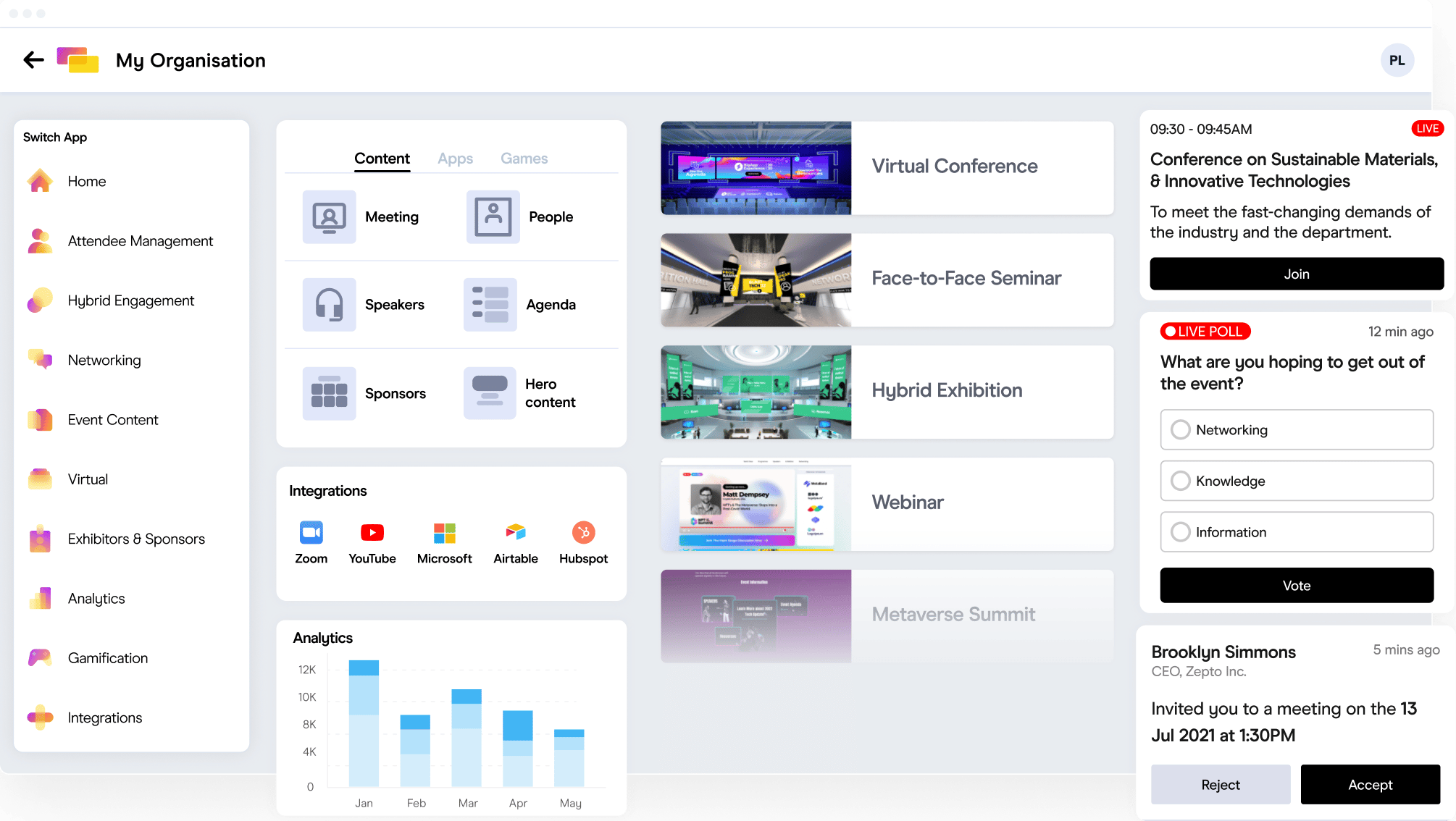Managing attendee flow is a critical component of large event management, directly impacting safety, attendee satisfaction, and overall event success. Inefficient crowd control can lead to severe consequences, including overcrowding, delays, and safety hazards. For instance, the Notting Hill Carnival in London, which attracts over a million attendees annually, has faced significant crowd management challenges. In 2024, concerns were raised about the potential for “mass casualty” incidents due to inadequate stewarding and overcrowding. Conversely, the Maha Kumbh Mela in India, expecting over 400 million pilgrims in 2025, has integrated advanced technologies like AI-driven surveillance and drones to monitor and manage massive crowds effectively. These examples underscore the importance of strategic planning and innovative solutions to manage attendee flow at large-scale events.
Strategic Venue Design and Layout
A well-planned venue layout is fundamental to facilitating smooth attendee movement and preventing congestion. Key considerations include:
- Clear Signage and Wayfinding: Implementing prominent, easy-to-read signs helps attendees navigate the venue efficiently, reducing confusion and bottlenecks.
- Designated Entry and Exit Points: Establishing separate, clearly marked entrances and exits can streamline movement and minimize cross-traffic.
- Zoning and Space Allocation: Dividing the venue into specific zones for different activities or attendee groups can prevent overcrowding in any single area.
- Emergency Egress Routes: Ensuring there are accessible, well-marked emergency exits is crucial for rapid evacuation if necessary.
For example, the London Marathon employs multiple measures to guide participants and spectators, including staggered starts, designated waiting areas, and clear pathways, effectively managing the flow of over 40,000 runners and thousands of spectators. Implementing such strategic layouts not only enhances navigation but also contributes significantly to overall event safety and attendee satisfaction.
Leveraging Technology for Real-Time Crowd Monitoring
Integrating advanced technology into large event management has become indispensable to effectively manage attendee flow.
IoT-Based Crowd Monitoring Solutions
The adoption of Internet of Things (IoT) devices has revolutionized crowd management by providing real-time data on attendee movements. For instance, the Starlite Occident festival implemented an advanced IoT-based crowd monitoring solution developed by Libelium. This technology allowed organizers to monitor visitor numbers and movement patterns, facilitating efficient crowd flow management. The integration with the festival’s mobile app further empowered attendees with real-time information, enhancing their event experience.
Mobile Applications for Attendee Navigation
Mobile applications equipped with real-time updates and navigation assistance can significantly improve attendee movement within large venues. By providing interactive maps, event schedules, and congestion alerts, these apps help attendees make informed decisions about their movements, thereby reducing overcrowding in specific areas.
Artificial Intelligence and Predictive Analytics
Artificial Intelligence (AI) and predictive analytics play a crucial role in forecasting crowd behavior and identifying potential congestion points before they become problematic. By analyzing historical data and real-time inputs, AI systems can predict peak times and areas of high traffic, enabling organizers to implement preemptive measures such as redirecting flows or opening additional access points.
Effective Communication Strategies
Clear and timely communication is vital to manage attendee flow and ensure seamless large event management.
Pre-Event Communication
Establishing clear communication channels before the event sets expectations and provides attendees with essential information. This includes details about venue layout, entry and exit points, event schedules, and behavioral guidelines. Utilizing emails, social media platforms, and the event’s official website ensures that attendees are well-informed prior to arrival.
On-Site Signage and Announcements
During the event, strategically placed signage and regular announcements are crucial for guiding attendees and managing crowd movement. Clear, visible signs indicating directions, facilities, and emergency exits help prevent confusion and congestion. Public address systems can be used to make real-time announcements regarding schedule changes, safety information, or to manage crowd distribution effectively.
Utilizing Event Staff for Direct Communication
Trained event staff serve as direct points of contact for attendees, providing assistance and information as needed. Equipping staff with communication devices ensures they can relay information swiftly and coordinate effectively to manage crowd flow. Regular briefings and clear protocols enable staff to address attendee inquiries and respond to situations promptly.
Digital Platforms and Social Media
Leveraging digital platforms and social media channels during the event allows organizers to communicate real-time updates, address attendee concerns, and manage perceptions. Encouraging attendees to follow official channels for updates ensures they receive accurate information promptly.
Staff Training and Deployment
Effective crowd management at large-scale events hinges significantly on the proficiency and strategic placement of event staff. Properly trained personnel are essential for guiding attendees, managing queues, and responding adeptly to emergencies, thereby ensuring a seamless and safe event experience.
Comprehensive Training Programs
Investing in thorough training programs equips staff with the necessary skills to handle diverse crowd dynamics and potential incidents. Key training components should include:
- Crowd Management Techniques: Staff should be adept at directing attendee movement, alleviating congestion, and maintaining orderly queues. Training in recognizing and mitigating signs of crowd stress or panic is also crucial.
- Communication Skills: Effective communication is vital for conveying information clearly to attendees and coordinating efficiently with team members. This includes proficiency in using communication devices and public address systems.
- Emergency Response Procedures: Personnel must be prepared to act swiftly and appropriately during emergencies, such as evacuations or medical incidents. Regular drills and scenario-based training can enhance readiness.
Strategic Staff Deployment
The placement of staff throughout the venue should be strategic to optimize attendee flow and address potential issues promptly:
- Entrances and Exits: Positioning staff at key access points facilitates efficient entry and exit, helps in managing queues, and ensures that only authorized individuals gain access.
- High-Traffic Areas: Assigning personnel to locations prone to congestion, such as food courts, restrooms, and merchandise stalls, aids in directing flow and preventing bottlenecks.
- Emergency Exits and First Aid Stations: Staff stationed near emergency exits and medical aid stations can guide attendees swiftly during critical situations, enhancing overall safety.
Regular Performance Evaluations
Conducting periodic assessments of staff performance during events helps identify areas for improvement and ensures adherence to established protocols. Feedback sessions and refresher training courses can address any gaps in knowledge or performance.
By prioritizing comprehensive training and strategic deployment of staff, event organizers can significantly enhance crowd management, contributing to the safety and satisfaction of attendees.
Implementing Access Control Measures
Robust access control is fundamental to manage attendee flow, enhancing security, and improving the overall event experience. Modern technologies, particularly Radio Frequency Identification (RFID), have revolutionized access control systems at events.
RFID Wristbands for Seamless Entry
RFID wristbands have become increasingly popular for their efficiency and convenience:
- Contactless Access: Attendees can swiftly enter the venue or restricted areas by tapping their RFID wristbands against scanners, significantly reducing wait times and queues.
- Enhanced Security: Each wristband is uniquely coded, minimizing the risk of counterfeit tickets and unauthorized access.
- Multi-Functional Use: Beyond access, RFID wristbands can facilitate cashless transactions, social media integration, and attendee tracking, enriching the overall event experience.
Case Study: Osheaga Festival
The Osheaga Festival in Montreal exemplifies successful RFID implementation. Organizers issued over 75,000 RFID wristbands to attendees, artists, and staff, streamlining access control and integrating social media interactions. Attendees could link their wristbands to Facebook, enhancing engagement and providing a personalized experience.
Integration with Event Management Systems
Combining RFID access control with comprehensive event management platforms offers organizers real-time data on attendee movements, peak times, and popular areas within the venue. This information is invaluable for making informed decisions during the event and for planning future events.
Privacy and Data Security Considerations
While implementing RFID technology, it is imperative to address privacy concerns by ensuring that attendee data is encrypted and complies with relevant data protection regulations. Transparent communication with attendees about data usage fosters trust and compliance.
Post-Event Analysis and Continuous Improvement
Conducting a thorough post-event analysis is crucial for understanding the effectiveness of crowd management strategies and for informing future improvements.
Collecting Attendee Feedback
Gathering direct feedback from attendees provides valuable insights into their experiences and perceptions of crowd management. Utilizing post-event surveys can help organizers identify specific areas where crowd flow was efficient or problematic. According to a guide by Guidebook, post-event surveys are instrumental in assessing attendee satisfaction and pinpointing areas for improvement.
Analyzing Engagement Metrics
Examining engagement metrics such as session attendance, dwell times in various zones, and participation in activities can reveal patterns in attendee movement and congregation. This data helps in understanding which areas attracted more attendees and at what times, aiding in future space and schedule planning. As highlighted by Gevme, tracking these metrics is essential for measuring event success and identifying opportunities for enhancement.
Assessing Operational Efficiency
Evaluating the efficiency of operational aspects, including entry and exit processes, queue management, and staff responsiveness, is vital. Identifying bottlenecks or delays can inform adjustments to staffing levels, training, or venue layout in future events. Fielddrive emphasizes the importance of assessing these elements to ensure smooth operations and attendee satisfaction.
Implementing Improvements
Based on the analysis, organizers should develop an action plan to address identified issues. This may involve redesigning venue layouts, enhancing staff training programs, adopting new technologies for crowd monitoring, or improving communication strategies. Continuous improvement ensures that each event builds upon the successes and lessons of previous ones, leading to increasingly effective crowd management.
Final Thoughts
Effective management of attendee flow at large-scale events is a multifaceted endeavor that requires meticulous planning, strategic implementation, and ongoing evaluation.
To enhance your event’s attendee flow and overall success, consider leveraging Gevme’s comprehensive event management solutions. With features like frictionless registration, real-time data analytics, and seamless onsite check-in, Gevme empowers organizers to deliver exceptional event experiences. Discover how Gevme can support your next event.







